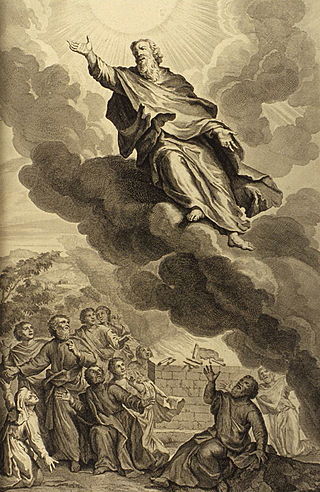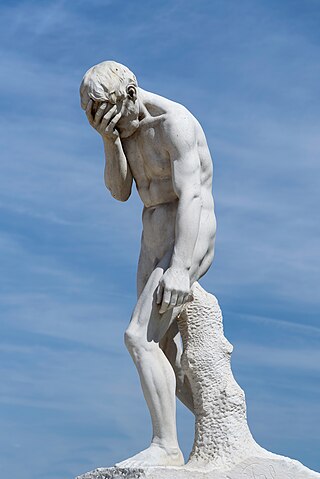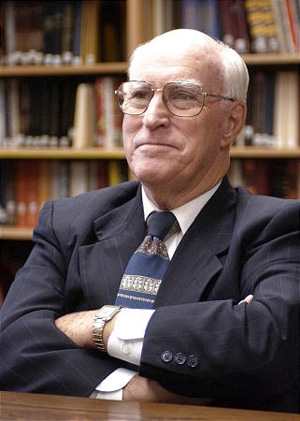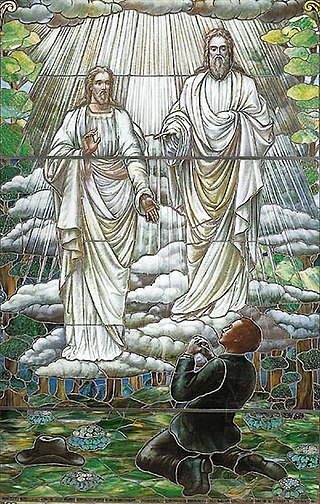
The Standard Works of the Church of Jesus Christ of Latter-day Saints are the four books that currently constitute its open scriptural canon. The four books of the standard works are:

Mormonism is the theology and religious tradition of the Latter Day Saint movement of Restorationist Christianity started by Joseph Smith in Western New York in the 1820s and 1830s. As a label, Mormonism has been applied to various aspects of the Latter Day Saint movement, although there has been a recent push from the Church of Jesus Christ of Latter-day Saints to distance themselves from this label. A historian, Sydney E. Ahlstrom, wrote in 1982 that, depending on the context, the term Mormonism could refer to “a sect, a mystery cult, a new religion, a church, a people, a nation, or an American subculture; indeed, at different times and places it is all of these."

Enoch is a biblical figure and patriarch prior to Noah's flood, and the son of Jared and father of Methuselah. He was of the Antediluvian period in the Hebrew Bible.
In Mormonism, the restoration refers to a return of the authentic priesthood power, spiritual gifts, ordinances, living prophets and revelation of the primitive Church of Christ after a long period of apostasy. While in some contexts the term may also refer to the early history of Mormonism, in other contexts the term is used in a way to include the time that has elapsed from the church's earliest beginnings until the present day. Especially in the Church of Jesus Christ of Latter-day Saints "the restoration" is often used also as a term to encompass the corpus of religious messages from its general leaders down to the present.

The Book of Abraham is a collection of writings from several Egyptian scrolls discovered in the early 19th century during an archeological expedition by Antonio Lebolo. Members of the Church of Jesus Christ of Latter-day Saints purchased the scrolls from a traveling mummy exhibition on July 3, 1835, to be translated into English by Joseph Smith. According to Smith, the book was "a translation of some ancient records... purporting to be the writings of Abraham, while he was in Egypt, called the Book of Abraham, written by his own hand, upon papyrus". Smith said the papyri described Abraham's early life, his travels to Canaan and Egypt, and his vision of the cosmos and its creation.

The Joseph Smith Translation (JST), also called the Inspired Version of the Holy Scriptures (IV), is a revision of the Bible by Joseph Smith, the founder of the Latter Day Saint movement, who said that the JST/IV was intended to restore what he described as "many important points touching the salvation of men, [that] had been taken from the Bible, or lost before it was compiled". Smith was killed before he deemed it complete, though most of his work on it was performed about a decade beforehand. The work is the King James Version of the Bible (KJV) with some significant additions and revisions. It is considered a sacred text and is part of the canon of Community of Christ (CoC), formerly the Reorganized Church of Jesus Christ of Latter Day Saints, and other Latter Day Saint churches. Selections from the Joseph Smith Translation are also included in the footnotes and the appendix of the Latter-day Saint edition of the LDS-published King James Version of the Bible. The Church of Jesus Christ of Latter-day Saints' edition of the Bible includes selections from the JST in its footnotes and appendix. It has officially canonized only certain excerpts that appear in the Pearl of Great Price. These excerpts are the Book of Moses and Smith's revision of part of the Gospel of Matthew.

According to most adherents of the Latter Day Saint movement, the Book of Mormon is a 19th-century translation of a record of ancient inhabitants of the American continent, which was written in a script which the book refers to as "reformed Egyptian". Mainstream modern linguistic evidence has failed to find any reliable evidence of a language matching this description - or indeed, any evidence of Old World linguistic influences in the New World whatsoever.

Master Mahan, in the religious texts of the Latter Day Saint movement, is a title assumed first by Cain and later by his descendant Lamech. The title indicates that Cain and Lamech were each the "master" of a "great secret" in which they covenanted with Satan to kill for personal gain. The term is found in Joseph Smith's translation of the Bible in Genesis 5 and in the Pearl of Great Price, a religious text of the Church of Jesus Christ of Latter-day Saints.

The curse of Cain and the mark of Cain are phrases that originated in the story of Cain and Abel in the Book of Genesis. In the stories, if someone harmed Cain, the damage would come back sevenfold. Some interpretations view this as a physical mark, whereas other interpretations see the "mark" as a sign, and not as a physical mark on Cain himself. The King James Version of the Bible reads "set a mark upon Cain".

The Pearl of Great Price is part of the canonical Standard Works of the Church of Jesus Christ of Latter-day Saints and some other Latter Day Saint denominations.
The Church of Jesus Christ of Latter-day Saints teaches that Adam and Eve were the first man and the first woman to live on the earth and that their fall was an essential step in the plan of salvation. Adam in particular is a central figure in Mormon cosmology.

Community of Christ and the Church of Jesus Christ of Latter-day Saints are two denominations that share a common heritage in the Church of Christ founded by Joseph Smith on April 6, 1830. Since Smith's death in 1844, they have evolved separately in belief and practices. The LDS Church is headquartered in Salt Lake City, Utah, and claims more than 17 million members worldwide; Community of Christ is headquartered in Independence, Missouri, and reports a worldwide membership of approximately 250,000.

Mormon cosmology is the description of the history, evolution, and destiny of the physical and metaphysical universe according to Mormonism, which includes the doctrines taught by leaders and theologians of the Church of Jesus Christ of Latter-day Saints, Mormon fundamentalism, and other denominations within the Latter Day Saint movement. Mormon cosmology draws from Biblical cosmology, but has many unique elements provided by movement founder Joseph Smith. These views are not generally shared by adherents of other Latter Day Saint movement denominations who do not self-identify as "Mormons", such as the Community of Christ.

Robert James Matthews was a Latter-day Saint religious educator and scholar, teaching in the departments of Ancient Scripture and Religious Education at Brigham Young University (BYU) in Provo, Utah.

The Book of Abraham is a work produced between 1835 and 1842 by the Latter Day Saints (LDS) movement founder Joseph Smith that he said was based on Egyptian papyri purchased from a traveling mummy exhibition. According to Smith, the book was "a translation of some ancient records ... purporting to be the writings of Abraham, while he was in Egypt, called the Book of Abraham, written by his own hand, upon papyrus". The work was first published in 1842 and today is a canonical part of the Pearl of Great Price. Since its printing, the Book of Abraham has been a source of controversy. Numerous non-LDS Egyptologists, beginning in the mid-19th century, have heavily criticized Joseph Smith's translation and explanations of the facsimiles, unanimously concluding that his interpretations are inaccurate. They have also asserted that missing portions of the facsimiles were reconstructed incorrectly by Smith.

The Church of Jesus Christ of Latter-day Saints focuses its doctrine and teaching on Jesus Christ; that he was the Son of God, born of Mary, lived a perfect life, performed miracles, bled from every pore in the Garden of Gethsemane, died on the cross, rose on the third day, appeared again to his disciples, and now resides, authoritatively, on the right hand side of God. In brief, some beliefs are in common with Catholics, Orthodox and Protestant traditions. However, teachings of the LDS Church differ significantly in other ways and encompass a broad set of doctrines, so that the above-mentioned denominations usually place the LDS Church outside the bounds of orthodox Christian teaching as summarized in the Nicene Creed.

The standard works of Mormonism—the largest denomination of which is the Church of Jesus Christ of Latter-day Saints —have been the subject of various criticisms. Latter-day Saints believe the Book of Mormon is a sacred text with the same divine authority as the Bible; both are considered complementary to each other. Other Mormon sacred texts include the Pearl of Great Price and Doctrine and Covenants, which are also recognized as scripture. Religious and scholarly critics outside Mormonism have disputed Mormonism's unique scriptures, questioning the traditional narrative of how these books came to light and the extent to which they describe actual events. Critics cite research in history, archeology, and other disciplines to support their contentions.
Islam and Mormonism have been compared to one another since the earliest origins of the latter in the nineteenth century, sometimes by detractors of one or both religions, but also at least once by Joseph Smith, founder of the Latter Day Saint movement, himself. Smith was also frequently referred to as "the Modern Muhammad" by several publications of the era, notably in the New York Herald, shortly after his assassination in June 1844. This epithet repeated a comparison that had been made from Smith's earliest career, one that was not intended at the time to be complimentary.

Brian M. Hauglid is an emeritus professor of ancient scripture at Brigham Young University (BYU). From 2014 to 2017, he was the editor-in-chief of the Journal of Book of Mormon Studies, and he was the director of the Laura F. Willes Center for Book of Mormon Studies, a part of BYU's Neal A. Maxwell Institute for Religious Scholarship.
This is a bibliography of works on the Latter Day Saint movement.












